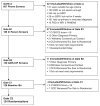Still Struggling: characteristics of youth with OCD who are partial responders to medication treatment
- PMID: 21484416
- PMCID: PMC3134148
- DOI: 10.1007/s10578-011-0227-4
Still Struggling: characteristics of youth with OCD who are partial responders to medication treatment
Abstract
The primary aim of this paper is to examine the characteristics of a large sample of youth with OCD who are partial responders (i.e., still have clinically significant symptoms) to serotonin reuptake inhibitor (SRI) medication. The sample will be described with regard to: demographics, treatment history, OCD symptoms/severity, family history and parental psychopathology, comorbidity, and global and family functioning. The sample includes 124 youth with OCD ranging in age from 7 to 17 with a primary diagnosis of OCD and a partial response to an SRI medication. The youth are a predominantly older (age 12 and over), Caucasian, middle to upper income group who had received significant past treatment. Key findings include moderate to severe OCD symptoms, high ratings of global impairment, and significant comorbidity, despite partial response to an adequate medication trial. Considerations regarding generalizability of the sample and limitations of the study are discussed.
Figures
Similar articles
-
Tic-related obsessive-compulsive disorder (OCD): phenomenology and treatment outcome in the Pediatric OCD Treatment Study II.J Am Acad Child Adolesc Psychiatry. 2014 Dec;53(12):1308-16. doi: 10.1016/j.jaac.2014.09.014. Epub 2014 Oct 2. J Am Acad Child Adolesc Psychiatry. 2014. PMID: 25457929 Free PMC article. Clinical Trial.
-
Secondary outcomes from the pediatric obsessive compulsive disorder treatment study II.J Psychiatr Res. 2017 Sep;92:94-100. doi: 10.1016/j.jpsychires.2017.04.001. Epub 2017 Apr 7. J Psychiatr Res. 2017. PMID: 28412602 Free PMC article. Clinical Trial.
-
Characteristics of Young Children with Obsessive-Compulsive Disorder: Baseline Features from the POTS Jr. Sample.Child Psychiatry Hum Dev. 2016 Feb;47(1):83-93. doi: 10.1007/s10578-015-0546-y. Child Psychiatry Hum Dev. 2016. PMID: 25820921 Clinical Trial.
-
A review of the efficacy of selective serotonin reuptake inhibitors in obsessive-compulsive disorder.J Clin Psychiatry. 1999 Feb;60(2):101-6. doi: 10.4088/jcp.v60n0206. J Clin Psychiatry. 1999. PMID: 10084636 Review.
-
[Diversity of obsessive-compulsive disorder and pharmacotherapy associated with obsessive-compulsive spectrum disorders].Seishin Shinkeigaku Zasshi. 2011;113(10):1016-25. Seishin Shinkeigaku Zasshi. 2011. PMID: 22187889 Review. Japanese.
Cited by
-
Tic-related obsessive-compulsive disorder (OCD): phenomenology and treatment outcome in the Pediatric OCD Treatment Study II.J Am Acad Child Adolesc Psychiatry. 2014 Dec;53(12):1308-16. doi: 10.1016/j.jaac.2014.09.014. Epub 2014 Oct 2. J Am Acad Child Adolesc Psychiatry. 2014. PMID: 25457929 Free PMC article. Clinical Trial.
-
Secondary outcomes from the pediatric obsessive compulsive disorder treatment study II.J Psychiatr Res. 2017 Sep;92:94-100. doi: 10.1016/j.jpsychires.2017.04.001. Epub 2017 Apr 7. J Psychiatr Res. 2017. PMID: 28412602 Free PMC article. Clinical Trial.
References
-
- Mullick M, Goodman R. The prevalence of psychiatric disorders in 5–10 year olds in rural, urban and slum areas in Bangladesh. Soc Psychiatry Psychiatr Epidemiol. 2005;40:663–671. - PubMed
-
- Valleni-Basile LA, Garrison CZ, Jackson KL, Waller JL, McKeown RE, Addy CL, et al. Frequency of obsessive-compulsive disorder in a community sample of young adolescents. J Am Acad Child Adol Psychiatry. 1995;34:128–129. - PubMed
-
- Flament MF, Koby E, Rapoport JL, Berg CJ, Zahn T, Cox C, et al. Childhood obsessive-compulsive disorder: a prospective follow-up study. J Child Psychol Psychiatry. 1990;31:363–380. - PubMed
-
- Leonard HL, Lenane M, Swedo SE. Obsessive-compulsive disorder. Child Adolesc Psychiatr Clin N Am. 1993;2:655–665. - PubMed
-
- Swedo SE, Rapoport JL, Leonard HL, Lenane M, Cheslow D. Obsessive compulsive disorders in children and adolescents: clinical phenomenology of 70 consecutive cases. Arch Gen Psychiatry. 1989;46:335–343. - PubMed
Publication types
MeSH terms
Substances
Grants and funding
LinkOut - more resources
Full Text Sources
Medical
Miscellaneous


